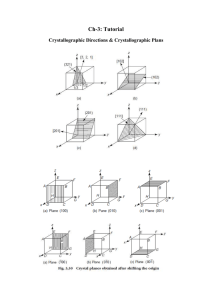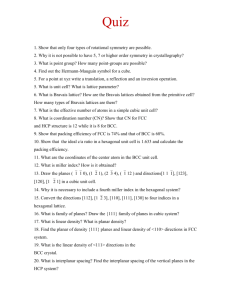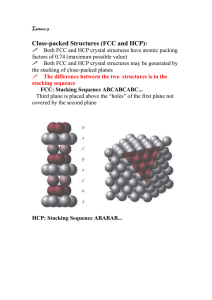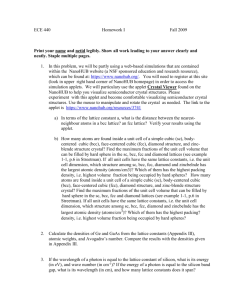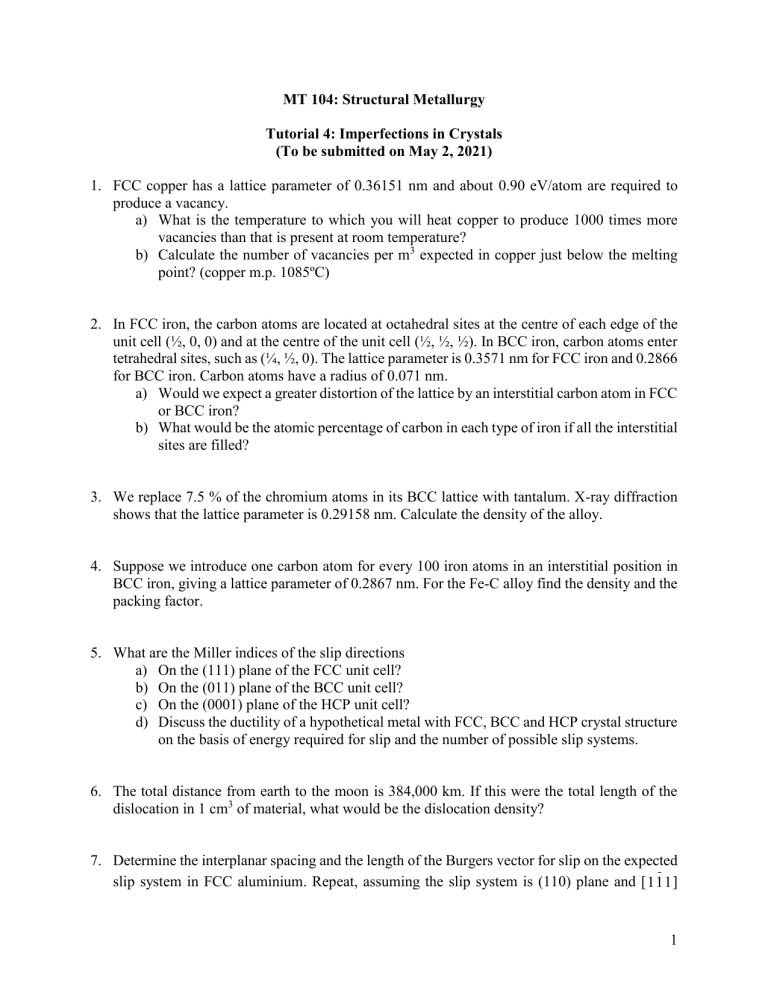
MT 104: Structural Metallurgy Tutorial 4: Imperfections in Crystals (To be submitted on May 2, 2021) 1. FCC copper has a lattice parameter of 0.36151 nm and about 0.90 eV/atom are required to produce a vacancy. a) What is the temperature to which you will heat copper to produce 1000 times more vacancies than that is present at room temperature? b) Calculate the number of vacancies per m3 expected in copper just below the melting point? (copper m.p. 1085ºC) 2. In FCC iron, the carbon atoms are located at octahedral sites at the centre of each edge of the unit cell (½, 0, 0) and at the centre of the unit cell (½, ½, ½). In BCC iron, carbon atoms enter tetrahedral sites, such as (¼, ½, 0). The lattice parameter is 0.3571 nm for FCC iron and 0.2866 for BCC iron. Carbon atoms have a radius of 0.071 nm. a) Would we expect a greater distortion of the lattice by an interstitial carbon atom in FCC or BCC iron? b) What would be the atomic percentage of carbon in each type of iron if all the interstitial sites are filled? 3. We replace 7.5 % of the chromium atoms in its BCC lattice with tantalum. X-ray diffraction shows that the lattice parameter is 0.29158 nm. Calculate the density of the alloy. 4. Suppose we introduce one carbon atom for every 100 iron atoms in an interstitial position in BCC iron, giving a lattice parameter of 0.2867 nm. For the Fe-C alloy find the density and the packing factor. 5. What are the Miller indices of the slip directions a) On the (111) plane of the FCC unit cell? b) On the (011) plane of the BCC unit cell? c) On the (0001) plane of the HCP unit cell? d) Discuss the ductility of a hypothetical metal with FCC, BCC and HCP crystal structure on the basis of energy required for slip and the number of possible slip systems. 6. The total distance from earth to the moon is 384,000 km. If this were the total length of the dislocation in 1 cm3 of material, what would be the dislocation density? 7. Determine the interplanar spacing and the length of the Burgers vector for slip on the expected slip system in FCC aluminium. Repeat, assuming the slip system is (110) plane and [ 1 1 1 ] 1 direction. What is the ratio between the shear stress required for slip for the two systems? Assume that the material constant, k=2 in the Peierls-Nebarro relationship. 8. Complete the data in the following table: Element Crystal Lattice structure parameter (nm) Pd FCC a = 0.38902 Be HCP a = 0.22858; c = 0.35842 Li BCC a = 0.35089 Pb FCC a = 0.4949 Density (g/cm3) 11.98 1.844 Fraction of vacant sites # of vacancies per m3 1 per 200 unit cells 1 per 500 Pb atoms 9. Suppose we introduce the following point defects. What other changes in each structure might be necessary to maintain a charge balance? Explain. a) Mg2+ ions substitute for yttrium atoms in Y2O3 b) Fe3+ ions substitute for magnesium ions in MgO c) Li+ ions substitute of magnesium ions in MgO d) Fe2+ ions replace sodium ions in NaCl 10. The angle of a tilt boundary is give by sin 2 b 2 D where b is the burgers vector and D is the spacing between dislocations. a) Prove this relationship b) Calculate the angle of a small-angle boundary in FCC aluminium when the dislocation are 500 nm apart. c) Calculate the average distance between dislocations in a small-angle grain boundary tilted at 0.5º in BCC iron. 11. Justify the following statements with reasons a) For an FCC single crystal, the surface energy for a (100) plane will be greater than that of a (111) plane. b) For a given material, the surface energy is greater than the grain boundary energy. c) For a given material, the grain boundary energy is greater than the tilt boundary energy. 2
